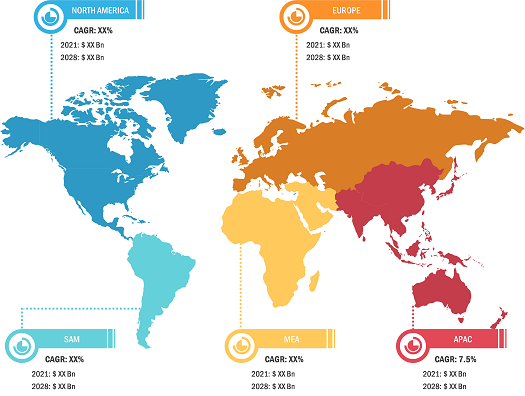$4450
$3560
The Air cargo market size is expected to reach US$ 210.92 billion by 2031 from US$ 141.03 billion in 2024. The market is anticipated to register a CAGR of 5.8% during 2025–2031.
Air cargo market Analysis
The air cargo market is growing rapidly, driven by increasing end-user demand due to evolving consumer preferences, technological advancements, and greater awareness of the product's benefits. As demand rises, businesses are expanding their offerings, innovating to meet consumer needs, and capitalizing on emerging trends, which further fuels market growth.
Air cargo market Overview
Air cargo is a transportation mode of delivering fast shipments through aircraft. It contributes to economic development by enhancing the capability of transporting valuable and superior quality products to consumers worldwide. Several advancements have been observed in the air cargo industry. Innovative logistics and supply chain concepts established on low-fuel costs as well as labor costs emerged as key trends in on-time production and end-point manufacturing assembly destination. Moreover, a surge in demand for expeditious shipping and control, as well as transparency, has been noticed with the decreasing shelf-life of new products such as consumer electronics.
Customize Research To Suit Your Requirement
We can optimize and tailor the analysis and scope which is unmet through our standard offerings. This flexibility will help you gain the exact information needed for your business planning and decision making.
Air Cargo Market: Strategic Insights

Market Size Value in US$ 123.90 Billion in 2022 Market Size Value by US$ 175.24 Billion by 2028 Growth rate CAGR of 5.9% from 2022 to 2028 Forecast Period 2022-2028 Base Year 2022

Naveen
Have a question?
Naveen will walk you through a 15-minute call to present the report’s content and answer all queries if you have any.
 Speak to Analyst
Air cargo market Drivers and Opportunities
Speak to Analyst
Air cargo market Drivers and Opportunities
Customize Research To Suit Your Requirement
We can optimize and tailor the analysis and scope which is unmet through our standard offerings. This flexibility will help you gain the exact information needed for your business planning and decision making.
Air Cargo Market: Strategic Insights

| Market Size Value in | US$ 123.90 Billion in 2022 |
| Market Size Value by | US$ 175.24 Billion by 2028 |
| Growth rate | CAGR of 5.9% from 2022 to 2028 |
| Forecast Period | 2022-2028 |
| Base Year | 2022 |

Naveen
Have a question?
Naveen will walk you through a 15-minute call to present the report’s content and answer all queries if you have any.
 Speak to Analyst
Speak to Analyst
Market Drivers:
Surging Adoption of E-Commerce Platforms :
Online retailing draws a larger audience than physical stores owing to its worldwide availability. In addition, e-commerce market players opt for logistics options such as surface transport and air transport to deliver packages to their customers. With the rise in the global e-commerce market, varying buying patterns and trends have been observed.Increasing Number of Partnerships and Collaborations:
In 2024, IndiGo CarGo signed an extensive interline agreement with Air France KLM Martinair Cargo. This partnership aims to enhance delivery accuracy and efficiency across their combined networks, expanding IndiGo's reach and improving cargo services between India and Europe.
Market Opportunities:
Airport Infrastructure and New Policies:
Air cargo stakeholders have a huge opportunity in Southeast Asian countries such as Singapore, Thailand, and Indonesia. Airports in Southeast Asian countries are the fastest-growing airports in the world. Turkish Cargo is increasing its presence with the launch of new freighter services.
Air cargo market Report Segmentation Analysis
The Air cargo market is divided into various segments to provide a more detailed understanding of its operations, growth opportunities, and emerging trends. Below is the standard segmentation approach used in most industry reports:
By Type:
Air Mail:
The air mail segment experienced a resurgence in 2024 owing to the accelerating growth of cross-border e-commerce and the increasing need for rapid, reliable delivery of small parcels and documents.Air Freight:
Air freight is the transportation of goods via an air carrier, which can be commercial or charter. With the increasing demand for quick delivery, preferences for express shipping are growing.
By Services:
Regular Service:
Regular air cargo encompasses general freight services for less time-sensitive and bulkier shipments. The segment holds the largest share of the global air cargo market in 2024.Express Service:
The express air cargo has emerged as the fastest-growing and most dynamic segment in the global air cargo market in 2024, underpinned by the relentless rise of e-commerce, escalating consumer expectations for same-day and next-day delivery, and the increasing prevalence of just-in-time supply chain models across industries.
By End User:
- Pharmaceuticals
- Retail
- Food and Beverages
- Consumer Electronics
- Others
Each industry type has specific requirements for air cargo. It influences relentless focus on speed, convenience, and sustainability.
By Geography:
- North America
- Europe
- Asia Pacific
- South & Central America
- Middle East & Africa
The Air cargo market in Asia Pacific is expected to witness the fastest growth. This growth is primarily driven by the expanding cross-border e-commerce sector.
Air Cargo Market Report ScopeAir cargo market Share Analysis by Geography
Asia Pacific is expected to grow the fastest in the next few years. Emerging markets in South & Central America, the Middle East, and Africa also have many untapped opportunities for air cargo providers to expand.
The Air cargo market grows differently in each region. This is because of factors such as the rise of the e-commerce industry and growing trade between various countries. Below is a summary of market share and trends by region:
1. North America
Market Share:
Holds a significant portion of the global marketKey Drivers:
- E-commerce growth is driving demand for fast and flexible shipping.
- High-tech and pharmaceutical exports require time-sensitive transport.
- Strong infrastructure and major cargo hubs (e.g., Memphis, Anchorage).
Trends:
Expansion of dedicated cargo fleets by passenger airlines to diversify revenue streams.
2. Europe
Market Share:
Substantial share due to early, stringent EU regulationsKey Drivers:
- Intra-European trade and manufacturing supply chains.
- Growing demand for express and perishable goods logistics.
- EU sustainability initiatives are pushing for efficient multimodal logistics.
Trends:
Adoption of green air cargo solutions and SAF (sustainable aviation fuel) for emissions reduction.
3. Asia Pacific
Market Share:
Fastest-growing region with dominant market shareKey Drivers:
- Massive e-commerce exports from China, South Korea, and Japan.
- Strong manufacturing and semiconductor supply chain dependencies.
- Strategic air freight corridors between Asia, North America, and Europe.
Trends:
Rise of cross-border e-commerce logistics platforms and digital freight forwarders.
4. South and Central America
Market Share:
Although small, it is growing quicklyKey Drivers:
- Export of perishables such as fruits, flowers, and seafood.
- Growing middle-class consumption is increasing the demand for imports.
- Investments in airport and cold-chain infrastructure.
Trends:
Shift toward regional cargo consolidation hubs to improve connectivity and reduce costs.
5. Middle East and Africa
Market Share:
Growing Market with steady progressKey Drivers:
- Strategic location as a transshipment hub between continents.
- National carrier investments in cargo fleets (e.g., Emirates SkyCargo, Qatar Airways Cargo).
- Oil, medical supplies, and electronics contribute to air freight volume.
Trends:
Development of integrated logistics cities and free trade zones near major airports (e.g., Dubai South, Kigali Logistics Platform).
Air cargo market Players Density: Understanding Its Impact on Business Dynamics
High Market Density and Competition
Competition is strong due to the presence of established players such FedEx Express, UPS Airlines, DHL Aviation. Regional and niche providers such as Emirates (UAE), and British Airways (UK) are also adding to the competitive landscape across different regions.
This high level of competition urges companies to stand out by offering:
- Investments in cargo fleets
- Investments in cold-chain infrastructure.
Opportunities and Strategic Moves
- Implementing AI, IoT, and blockchain for real-time tracking, route optimization, and demand forecasting.
- Digital freight platforms are reshaping forwarder–carrier relationships.
Major Companies operating in the Air cargo market are:
- FedEx Express. (US)
- UPS Airlines (US)
- DHL Aviation. (Germany)
- Emirates SkyCargo (Dubai)
- Cathay Pacific Airways Cargo (China)
- Korean Air Cargo (South Korea)
- Lufthansa Cargo (Germany)
- Singapore Airlines Cargo (Singapore)
- China Airlines Cargo. (Taiwan)
- British Airways World Cargo (UK)
Disclaimer: The companies listed above are not ranked in any particular order.
Other companies analysed during the course of research:
- Qatar Airways Cargo
- Turkish Cargo
- Etihad Cargo
- Ethiopian Cargo & Logistics Services
- Saudi Cargo (Saudia Cargo)
- Asiana Cargo
- Air France KLM Martinair Cargo
- AirBridgeCargo Airlines
- MASkargo (Malaysia Airlines Cargo)
- Nippon Cargo Airlines (NCA)
- Silk Way West Airlines
- LATAM Cargo
- Avianca Cargo
- Aerologic
- Kalitta Air
Air cargo market News and Recent Developments
SpiceXpress Partnered With Bengaluru-Based Star Air
SpiceXpress partnered with Bengaluru-based Star Air to manage belly space capacity in Star Air's fleet. This collaboration added nine new destinations to SpiceXpress's domestic network, strengthening door-to-door delivery and air cargo infrastructure, especially in underserved regions of India.Saudia Cargo Signed Two Major Global Logistics Partnership Agreements
Saudia Cargo signed two major global logistics partnership agreements—one with Denmark's Scan Global Logistics (SGL) and another with Air Logistics Group. The SGL partnership provides priority access to Saudia Cargo's global network, while the Air Logistics Group agreement enhances integrated air cargo solutions between the UK and Saudi Arabia.
Air cargo market Report Coverage and Deliverables
The "Air cargo market Size and Forecast (2021–2031)" report provides a detailed analysis of the market covering below areas:
- Air cargo market size and forecast at global, regional, and country levels for all the key market segments covered under the scope
- Air cargo market trends, as well as market dynamics such as drivers, restraints, and key opportunities
- Detailed PEST and SWOT analysis
- Air cargo market analysis covering key market trends, global and regional framework, major players, regulations, and recent market developments
- Industry landscape and competition analysis covering market concentration, heat map analysis, prominent players, and recent developments for the Air cargo market
- Detailed company profiles

Report Coverage
Revenue forecast, Company Analysis, Industry landscape, Growth factors, and Trends

Segment Covered
Type, Service, and End User

Regional Scope
North America, Europe, Asia Pacific, Middle East & Africa, South & Central America

Country Scope
Argentina, Australia, Brazil, Canada, China, France, Germany, India, Italy, Japan, Mexico, Russian Federation, Saudi Arabia, South Africa, South Korea, United Arab Emirates, United Kingdom, United States
Frequently Asked Questions
As of 2024, the global Air cargo market is valued at approximately USD 141.03 billion. It is projected to reach USD 210.92 billion by 2031, growing at a compound annual growth rate (CAGR) of 5.8% during the forecast period from 2025 to 2031.
The air mail segment is one of the oldest services provided by air cargo companies. The increasing trade of goods and the booming e-commerce sector have created a significant demand for air freight.
1. Surging Adoption of E-Commerce Platforms :
Online retailing draws a larger audience than physical stores owing to its worldwide availability. In addition, e-commerce market players opt for logistics options such as surface transport and air transport to deliver packages to their customers. With the rise in the global e-commerce market, varying buying patterns and trends have been observed.
2. Increasing Number of Partnerships and Collaborations:
The increasing number of partnerships and collaborations among the key players is driving the air cargo market growth.
Major players include FedEx Corporation, DHL, UPS, Lufthansa, and Cathy Pacific Cargo, among others.
Key industries utilizing air cargo include:
Retail: Major players: Amazon, Alibaba, JD.com, Shopify sellers, etc. High volumes of small packages and consumer goods; demand fast delivery (B2C & B2B).
Pharmaceutical: Shipments include vaccines, biologics, medical equipment, and temperature-sensitive drugs.
Food or Beverage: Includes exporters of fresh fruits, vegetables, flowers, seafood, and meat.
Consumer Electronics: Movement of sensitive and high-value microchips, circuit boards, and hardware.
Automotive: Critical components, spare parts, and prototypes.
Airport Infrastructures are revolutionizing Air Cargos by:
Enhancing Greenfield Airports Capabilities: The increasing construction of greenfield airports across Europe is likely to provide new market opportunities for air cargo companies during the forecast period
As of 2025:
Asia Pacific: Dominates the market with a share of approximately 30.15%, driven by the expanding cross-border e-commerce sector, which has fueled an uptick in express shipments from China, Hong Kong, and Southeast Asia.
North America: Holds a 25.8% market share, due to the boom in cross-border e-commerce influences consumer expectations for two-day delivery and creates high demand for rapid air freight services.
Europe: The significant-growing region, with a projected CAGR of 6.0% from 2025 to 2031, primarily driven by Intra-European trade and manufacturing supply chains, and EU sustainability initiatives pushing for efficient multimodal logistics.
Challenges include:
Regulatory Changes and Disputes Between Countries: Several regulatory changes and disputes between countries are going on worldwide. The US-China trade war is the key factor that is negatively influencing market growth.
The List of Companies - Air Cargo Market
- FedEx Express
- Emirates SkyCargo
- UPS Airlines
- Cathay Pacific Cargo
- Qatar Airways Cargo
- Korean Air Cargo
- Lufthansa Cargo
- Cargolux
- Singapore Airlines Cargo
- Air China Cargo
- China Airlines Cargo
- AirBridgeCargo Airlines
- Etihad Cargo
- All Nippon Airways (ANA) Cargo
- Polar Air Cargo
- IAG Cargo
- Asiana Airlines Cargo
- Turkish Cargo
- KLM Cargo
- United Airlines Cargo
- EVA Air Cargo
- LATAM Cargo
- Atlas Air
- DHL Aviation
- Saudi Airlines Cargo
- Silk Way West Airlines
- Icelandair Cargo
- Cargojet
- Blue Dart Aviation
The Insight Partners performs research in 4 major stages: Data Collection & Secondary Research, Primary Research, Data Analysis and Data Triangulation & Final Review.
- Data Collection and Secondary Research:
As a market research and consulting firm operating from a decade, we have published many reports and advised several clients across the globe. First step for any study will start with an assessment of currently available data and insights from existing reports. Further, historical and current market information is collected from Investor Presentations, Annual Reports, SEC Filings, etc., and other information related to company’s performance and market positioning are gathered from Paid Databases (Factiva, Hoovers, and Reuters) and various other publications available in public domain.
Several associations trade associates, technical forums, institutes, societies and organizations are accessed to gain technical as well as market related insights through their publications such as research papers, blogs and press releases related to the studies are referred to get cues about the market. Further, white papers, journals, magazines, and other news articles published in the last 3 years are scrutinized and analyzed to understand the current market trends.
- Primary Research:
The primarily interview analysis comprise of data obtained from industry participants interview and answers to survey questions gathered by in-house primary team.
For primary research, interviews are conducted with industry experts/CEOs/Marketing Managers/Sales Managers/VPs/Subject Matter Experts from both demand and supply side to get a 360-degree view of the market. The primary team conducts several interviews based on the complexity of the markets to understand the various market trends and dynamics which makes research more credible and precise.
A typical research interview fulfils the following functions:
- Provides first-hand information on the market size, market trends, growth trends, competitive landscape, and outlook
- Validates and strengthens in-house secondary research findings
- Develops the analysis team’s expertise and market understanding
Primary research involves email interactions and telephone interviews for each market, category, segment, and sub-segment across geographies. The participants who typically take part in such a process include, but are not limited to:
- Industry participants: VPs, business development managers, market intelligence managers and national sales managers
- Outside experts: Valuation experts, research analysts and key opinion leaders specializing in the electronics and semiconductor industry.
Below is the breakup of our primary respondents by company, designation, and region:

Once we receive the confirmation from primary research sources or primary respondents, we finalize the base year market estimation and forecast the data as per the macroeconomic and microeconomic factors assessed during data collection.
- Data Analysis:
Once data is validated through both secondary as well as primary respondents, we finalize the market estimations by hypothesis formulation and factor analysis at regional and country level.
- 3.1 Macro-Economic Factor Analysis:
We analyse macroeconomic indicators such the gross domestic product (GDP), increase in the demand for goods and services across industries, technological advancement, regional economic growth, governmental policies, the influence of COVID-19, PEST analysis, and other aspects. This analysis aids in setting benchmarks for various nations/regions and approximating market splits. Additionally, the general trend of the aforementioned components aid in determining the market's development possibilities.
- 3.2 Country Level Data:
Various factors that are especially aligned to the country are taken into account to determine the market size for a certain area and country, including the presence of vendors, such as headquarters and offices, the country's GDP, demand patterns, and industry growth. To comprehend the market dynamics for the nation, a number of growth variables, inhibitors, application areas, and current market trends are researched. The aforementioned elements aid in determining the country's overall market's growth potential.
- 3.3 Company Profile:
The “Table of Contents” is formulated by listing and analyzing more than 25 - 30 companies operating in the market ecosystem across geographies. However, we profile only 10 companies as a standard practice in our syndicate reports. These 10 companies comprise leading, emerging, and regional players. Nonetheless, our analysis is not restricted to the 10 listed companies, we also analyze other companies present in the market to develop a holistic view and understand the prevailing trends. The “Company Profiles” section in the report covers key facts, business description, products & services, financial information, SWOT analysis, and key developments. The financial information presented is extracted from the annual reports and official documents of the publicly listed companies. Upon collecting the information for the sections of respective companies, we verify them via various primary sources and then compile the data in respective company profiles. The company level information helps us in deriving the base number as well as in forecasting the market size.
- 3.4 Developing Base Number:
Aggregation of sales statistics (2020-2022) and macro-economic factor, and other secondary and primary research insights are utilized to arrive at base number and related market shares for 2022. The data gaps are identified in this step and relevant market data is analyzed, collected from paid primary interviews or databases. On finalizing the base year market size, forecasts are developed on the basis of macro-economic, industry and market growth factors and company level analysis.
- Data Triangulation and Final Review:
The market findings and base year market size calculations are validated from supply as well as demand side. Demand side validations are based on macro-economic factor analysis and benchmarks for respective regions and countries. In case of supply side validations, revenues of major companies are estimated (in case not available) based on industry benchmark, approximate number of employees, product portfolio, and primary interviews revenues are gathered. Further revenue from target product/service segment is assessed to avoid overshooting of market statistics. In case of heavy deviations between supply and demand side values, all thes steps are repeated to achieve synchronization.
We follow an iterative model, wherein we share our research findings with Subject Matter Experts (SME’s) and Key Opinion Leaders (KOLs) until consensus view of the market is not formulated – this model negates any drastic deviation in the opinions of experts. Only validated and universally acceptable research findings are quoted in our reports.
We have important check points that we use to validate our research findings – which we call – data triangulation, where we validate the information, we generate from secondary sources with primary interviews and then we re-validate with our internal data bases and Subject matter experts. This comprehensive model enables us to deliver high quality, reliable data in shortest possible time.
Trends and growth analysis reports related to Air Cargo Market

Aug 2025
Back of Cab Market
Size and Forecast (2021 - 2031), Global and Regional Share, Trend, and Growth Opportunity Analysis Report Coverage: By Vehicle Type (Light-duty Commercial Vehicles, Medium-duty Commercial Vehicles, and Heavy-duty Commercial Vehicles), Application (Fuel Tanks and General Storage), Fuel Tank (CNG and Hydrogen); and Geography

Aug 2025
Heavy Commercial Vehicle Air Brake Systems Market
Size and Forecast (2021 - 2031), Global and Regional Share, Trend, and Growth Opportunity Analysis Report Coverage: By Component (Compressor, Reservoir, Foot Valve, Brake Lining and Drum or Rotors, Brake Shoes, and Others), Type (Air Disc Brake and Air Drum Brake), Technology (Conventional Air Brake System, Electronically Controlled Air Braking System, and Antilock Braking System), Distribution Channel (OEMs and Aftermarket), Vehicle Type (Bus, Truck, Construction Equipment, and Tractor), and Geography

Aug 2025
Heavy Commercial Vehicle Clutch Market
Size and Forecast (2021 - 2031), Global and Regional Share, Trend, and Growth Opportunity Analysis Report Coverage: By Distribution Channel (OEM and Aftermarket), Product (Single Plate Clutches, Multi-Plate Clutches, Diaphragm Spring Clutches, Centrifugal Clutches, and Hydraulic Clutches), Vehicle Type (Bus, Truck, Construction Equipment, and Tractors), and Geography

Aug 2025
Electric Vehicle Heat Pump Systems Market
Size and Forecast (2021 - 2031), Global and Regional Share, Trend, and Growth Opportunity Analysis Report Coverage: By Propulsion Type (BEV, HEV, PHEV), Component (Evaporator, Condenser, Compressors, Others), Vehicle Type (Passenger Vehicle, Commercial Vehicle), and Geography

Aug 2025
Hydrogen Fuel Cell Train Market
Size and Forecast (2020–2030), Global and Regional Share, Trend, and Growth Opportunity Analysis Report Coverage: By Technology (Proton Exchange Membrane Fuel Cell, Phosphoric Acid Fuel Cell, and Others), Component (Hydrogen Fuel Cell Pack, Batteries, Electric Traction Motors, and Others), Rail Type (Passenger Rail, Commuter Rail, Light Rail, Trams, Freight, and Others) and Geography

Aug 2025
Automotive Seat Market
Size and Forecast (2020–2030), Global and Regional Share, Trend, and Growth Opportunity Analysis Report Coverage: By Technology (Heated, Heated-Ventilated, Ventilated, With Massage Functions, and Others), Adjustment Type (Electrically Adjusted and Manual), Vehicle Type (Passenger Vehicle, Light Commercial Vehicle, and Heavy Commercial Vehicle), and Seat Type (Front Row, Second Row, and Third Row) and Geography

Aug 2025
Air Cargo Market
Size and Forecast (2021 - 2031), Global and Regional Share, Trend, and Growth Opportunity Analysis Report Coverage: By Type (Air Mail and Air Freight), Services (Express and Regular), End User (Retail, Pharmaceutical, Food and Beverage, Consumer Electronics, Automotive, and Others), and Geography